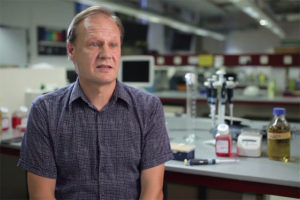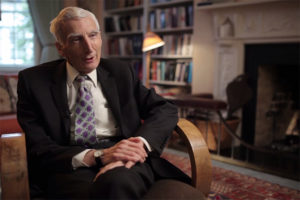Genetics of Obesity and Diabetes
Epidemiologist Nick Wareham on leptin, type 2 diabetes, and genome-wide association studies
The video is a part of the project British Scientists produced in collaboration between Serious Science and the British Council.
I’ve devoted many years to this research on paradise on maps. I remember that many years ago I went to Rome and then I asked the Vatican Library to reproduce some of the maps they had in their possession. I specified in my application that I needed a reproduction of the whole map and all the detail of the earthly paradise on those maps. Then I came back to London and I was waiting for the answer. Then, after a couple months, the bad news came. I was run by one staff of the Vatican Library, they told me that they located in maps, but they were not able to find the earthly paradise. Then I thought: “Oh dear, if in the Vatican they don’t know where the earthly paradise is, we are really in trouble”. So I thought I must find out about this.
Then I discovered that people were already troubled many centuries ago. Because at the beginning of the whole story people read the Bible. Augustine told that they had to read the Bible in a literal way. So, if a garden is mentioned that meant that this garden had been and still was on Earth. They accepted more or less that it was vaguely located in a distant East, but then this nowhere had to be located somewhere. Then problems became to emerge already around the 12th – 13th centuries, when we had a Scientific Revolution in the West, the introduction of the Greek science through the mediation of the Arab scholars, which completely renewed the approach to geography and astronomy.
Christian scholars, such as Thomas Aquinas, were very brave, they accepted the challenge. They wanted to show through the new scientific tools that the Bible was right, that actually there was a Garden of Eden somewhere on the globe. And this is a fascinating history, I think. Because it was a kind of impossible attempt to locate the unlocatable. There was something about this notion, which was intriguing: this place was completely separated from the daily life, from the known world, yet it was still connected to it. There was a separation: a temporal separation (the fall of Adam and Eve) and geographical separation (a barrel of fire, a navigable ocean, very high peak). But then the connection was ensured by the four rivers, because the text of the Bible mentions four rivers: the Gichon, the Pishon, which were interpreted as the Nile and the Ganges, the Tigris and Euphrates, which were really well-known rivers. So, there was a connection. This place was on Earth, but not of the Earth.
But, of course, in the 14th century the disappointment came, because it was impossible to locate the Garden of Eden. There was no agreement, there were also many factors involved in this fall of a notion. And the main factors, to cut a very long story short, first of all, that new information came into Western Europe from the East. In around 1200 many European travelers went to the East – Marco Polo, Niccolo de Conti – there were travel reports, and nobody came across anything like the earthly paradise.
Then the production of culture shifted from monasteries to universities in mercantile cities. Then the emergence of nautical cartography – people began to map worlds of the present to include the calculation of distance, proportion, to think more of modern trade and less of biblical or classical history. Then the rediscovery of Ptolemy and the new kind of modern mapping. Perhaps, we can think of the Italian novel ‘The Leopard’ of the 19th century, where one of the characters says: “Everything has to change, so that nothing changes”. And this happens to the mapping of paradise.
The medieval mapping or paradise was transformed into what I would call the modern, the Renaissance, mapping of paradise. In between there is a transitional period, which is very fascinating, including beautiful maps of the 15th century, where you find the original notion, the original map sign indicating paradise in a completely different cartographical context. Map makers in the 15th century no longer mapped the universal history and geography of mankind. They were much more interested in and informed about contemporary geography, trade. In the East there was Kathai or the Arabs had told them about the coasts of Africa. There was new information that had to be taken into account. Yet they still mapped the Garden of Eden somewhere in the East.
But then around 1500 – the turning point. Again I have to cut a long story short, but what’s happened is that suddenly in order to keep the truthfulness of scripture Christian scholars began to look at a paradise in the past. There was always something implicit in the medieval notion – paradise belonged to the past, because paradise was the place of Adam and Eve. But for the medieval scholars paradise was still on Earth, was still in the present, even though it was an unknown and unapproachable, unthinkable present in geographical reality.
The very first scholar to think that the Garden of Eden was no longer on Earth was actually a catholic, the librarian of the Vatican Library, Augustinus Steucus. And then curiously this became then later a typical protestant argument against catholic tradition. Luther played a very important role, because Luther thought that the Garden of Eden was left empty after the banishment of Adam and Eve, but then was completely destroyed by the flood. You see the parallel, not the human nature, the sin corrupted us, the sin corrupted the Earth. There is no longer Eden on the Earth. For Luther no maps of paradise would be possible, because the Earth changed completely after the flood. The flood destroyed the four rivers, destroyed everything.
What allowed the modern flourishing of maps of paradise was the very complex theological thinking of Calvin. Calvin had a slightly different approach from Luther. Yes it is true that sin destroyed us, but God didn’t abandon us, God cares for us, God wanted to give a sign of love to man. In one of these signs of love according to Calvin was the four rivers of Eden still here. Calvin reassured the readers of his commentary of Genesis published in 1556, I think, by saying: “Yes, we were expelled from paradise, but we are meant to be on Earth, on our journey to heaven. God is caring after us and shows us his benevolence by keeping the four rivers. Calvin provided the map of these four rivers.
Calvin’s map is the very first example of a very rich torrent of modern photography. Because after Calvin subsequent map-makers, without the complex theological thinking of Calvin, wanted to specify exactly the longitude and latitude of the Garden of Eden. Calvin in his map of Eden did not actually locate Eden precisely, he just said it was in Mesopotamia, because Mesopotamia is a fertile land and you find here the four rivers.
But this kind of modern paradise is very different from the Medieval paradise. You may go to Iran or to Mesopotamia, especially now, you wouldn’t find the Garden of Eden, because it disappeared. So the modern Renaissance mapping of Eden is an archeological, historical, regional cartography. This is just the very isolated portion of the Earth, where the Garden of Eden was located once, but it’s no longer there. Medieval mapping was wider cartography including the whole of history of salvation, where the location of paradise was left in a distant, remote East.
This is the difference between the Medieval mapping of paradise and the modern mapping of paradise. In the Middle Ages there is still the idea that paradise is on Earth, even though distant in a remote East or anywhere else. In the modern mapping of paradise it is in the known part of the Earth, but it’s no longer there, it is in the past. A typical paradise on Earth but distanced somewhere else is Dante’s paradise, but Dante’s paradise is a part of a journey, is a part of a narrative going from the Earth through the depths of hell as the only way to rise up to the light, to heaven. Dante, the pilgrim, has to go through the geography, which is a medieval geography, to access Heaven. In this way we can say that Dante is an old poet like Milton, and he, as a poet, anticipates the conclusion of scientists, seeing the notion of the Garden of Eden as a preliminary stepping stage towards heaven, because modern marking of paradise would then emphasize the importance of heavenly paradise and forget this issue that occupied the most brilliant minds of the Middle Ages so much. but it no longer does. If you approach any clerics or biblical scholars, or important theologians of any Christian denominations, they are not worried about the latitude or longitude of the Garden of Eden, they have other things to worry about.

Epidemiologist Nick Wareham on leptin, type 2 diabetes, and genome-wide association studies

Molecular biologist Greg Towers on the great scientific challenges, the dangers of gene therapy, and the way i...

Cosmologist Martin Rees on the history of astronomy, first nanoseconds of the universe and the theory of multi...